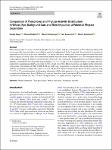Item Infomation
Full metadata record
| DC Field | Value | Language |
|---|---|---|
| dc.contributor.author | Natalie, Mayer | - |
| dc.contributor.author | Niklas, Widderich | - |
| dc.contributor.author | Marvin, Scherzinger | - |
| dc.date.accessioned | 2023-04-20T07:30:18Z | - |
| dc.date.available | 2023-04-20T07:30:18Z | - |
| dc.date.issued | 2023 | - |
| dc.identifier.uri | https://link.springer.com/article/10.1007/s11947-022-02981-3 | - |
| dc.identifier.uri | https://dlib.phenikaa-uni.edu.vn/handle/PNK/8151 | - |
| dc.description | CC BY | vi |
| dc.description.abstract | When facing today’s scarcity of mineral phosphorus (P) resources and the environmental issues following enhanced P losses especially from agriculture, new solutions need to be implemented. In this framework, the potential for a mechanical separation of a P rich grain fraction from wheat, rye, barley and oats is investigated in order to provide animal feed with reduced organic P content. Thus, P accumulation in manure and soils should be prevented. Also, the subsequent utilization of the separated organic P, which occurs in the form of inositol P, for a sustainable P management via activation of intrinsic enzymes is evaluated. It was shown that in grain layers at 7.0, 5.5, 6.4 and 2.5% cross section of wheat, rye, barley and oats, respectively, maximum inositol P occurs with 1.6, 0.8, 1.4 and 1.2 g/100 g. Phytase activity is also highest in the outer layers of the grains with maxima of 9300, 12,000, 8400 and 2400 U/kg, respectively. | vi |
| dc.language.iso | en | vi |
| dc.publisher | Springer | vi |
| dc.subject | mineral phosphorus (P) resources | vi |
| dc.subject | Phytase Activity Distribution in Wheat | vi |
| dc.title | Comparison of Phosphorus and Phytase Activity Distribution in Wheat, Rye, Barley and Oats and Their Impact on a Potential Phytate Separation | vi |
| dc.type | Book | vi |
| Appears in Collections | ||
| OER - Khoa học Tự nhiên | ||
Files in This Item:

